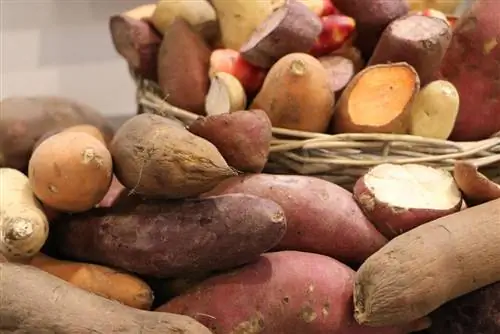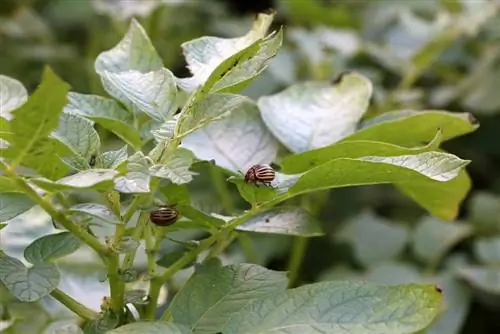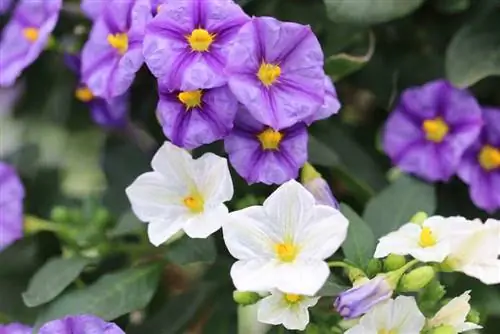- Author admin [email protected].
- Public 2023-12-17 03:39.
- Last modified 2025-01-24 12:45.
The range of potatoes offers over 5,000 varieties worldwide, which are divided into different ripeness and property groups. These include a large number of commercial varieties that are used to produce starch and alcohol. Potatoes come in the maturity groups very early to early, medium early, medium late and very late. Some potato varieties only have regional significance or are exchanged or traded between lovers as so-called “old varieties”. Depending on how firm they are when cooked, potatoes are differentiated between waxy and floury.
Federal Variety Office
In Germany, according to the provisions of the Seed Traffic Act, seedlings may only be marketed from potato varieties that are recognized and approved by the Federal Plant Variety Office. The list is updated annually and contains both very old and new potato varieties that are grown in Germany.
Differentiation by cooking type
When choosing the type of potato for table potatoes, the cooking properties or suitability for different dishes are important. Therefore, the cooking properties of a potato are also examined as part of a test. Potatoes are divided into the following categories:
- Cooking type A: waxy variety
- Cooking type B: predominantly waxy variety, slightly floury
- Cooking type C: loose, floury, slightly dry variety
Differentiation according to ripening time
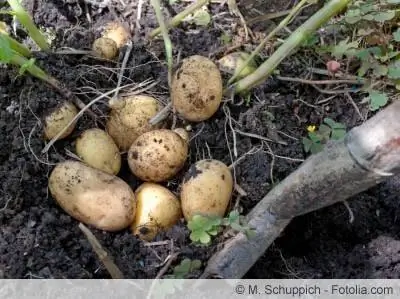
The ripening time not only determines the time it takes a potato to ripen, but also the harvest time and the shelf life of the potato variety. The range of varieties covers growing times between 90 and 170 days.
- Maturity group Ia (very early varieties): vegetation period 90-110 days, harvest in June and July, are pre-germinated under foil, mostly predominantly waxy varieties, not storable
- Maturity group IIa (early varieties): vegetation period 110-130 days, harvest in July and August, are often pre-germinated, mostly waxy and predominantly waxy varieties, can only be stored until autumn
- Maturity group IIIa (mid-early varieties): vegetation period 130-150 days, harvest in August and September, all three cooking types, typical potatoes for cellaring, can be stored until at least the end of the year
- Maturity group IVa (mid-late to late varieties): vegetation period 150-170 days, harvest in September and October, mostly predominantly waxy and floury varieties, cellaring possible until the next early summer
Wayy potato varieties
Way-cooking potato varieties are characterized by the fact that they retain their structure when cooked and do not burst open; the cut surface is smooth and moist. Waxy potatoes are suitable for preparation as boiled and jacket potatoes, fried potatoes, gratins, salads, French fries.
Very early maturity group
- Heidi (approved 2009): long-oval tuber shape with yellow, smooth skin and yellow flesh color
- Salome (2001): oval, shapely tuber, yellow peel and yellow flesh, stores well when ripe
Early Maturity Group
- Belana (approved in 2000): oval tuber, successor to the Linda variety, fine-skinned yellow, flesh color yellow, intense taste
- Campina (2009): oval tuber with yellow, smooth skin, yellow flesh color
- Cilena (1981): elongated tuber shape, yellow skin and yellow flesh, is one of the most popular potatoes, stores well
- Goldmarie (2013): long oval tuber, deep yellow flesh color
- Renate (1993): oval tuber shape, yellow peel with yellow flesh
- Venezia (2009): long oval tuber with very smooth yellow skin, deep yellow flesh color
Mid-early maturity group
- Ditta (approved in 1991): high yield, long oval tuber, yellow peel and yellow flesh
- Nicola (1973): high yield, long oval tuber, yellow peel and light yellow flesh
- Selma (1972): long oval tuber, yellow peel and yellow flesh
Predominantly waxy
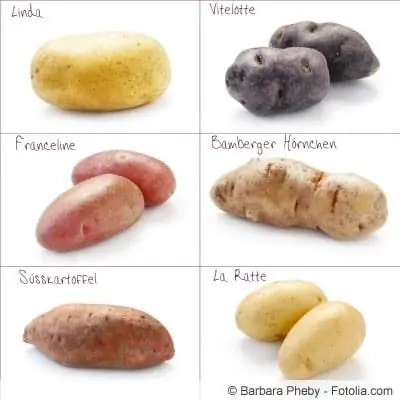
All potatoes described as predominantly waxy develop a medium firmness when cooked, which offers little resistance when mashing with a fork. The peel of these types of potatoes cracks only slightly when cooked and their flesh appears fine-grained and only slightly floury. Mainly waxy potatoes are ideal in the kitchen for preparation as boiled and jacket potatoes, for stews and casseroles, soups, buffers or röstis.
Very early maturity group
- Arkula (approved in 1975): round-oval tuber, yellow peel and light yellow flesh
- Berber (1983): oval tuber, yellow peel with light yellow flesh
- Christa (1975): long oval tuber, yellow peel and yellow flesh
- Leyla (1988): oval tuber, yellow peel and yellow flesh color
- Rosara (1990): long oval tuber, red peel and yellow flesh
Early ripening period
Marabel (approval 1993): oval tuber, yellow peel and yellow flesh
Medium early ripening period
- Agria (approved in 1985): oval tuber shape, yellow peel and flesh
- Désirée (1962): red shell with light yellow flesh
- Granola (1975): round oval shape, yellow peel and yellow flesh
- Quarta (1979): oval tuber, yellow peel with red eyes, yellow flesh
- Satina (1993): round-oval tuber, yellow peel and light yellow flesh
- Secura (1985): oval tuber, yellow peel and flesh color
- Solara (1989): oval tuber, yellow peel and yellow flesh
Medium-late to very late ripening period
- Cascada (approval 2009): very high yield, oval tuber with yellow, smooth skin, yellow flesh
- Donella (1990): many uniform oval tubers, yellow peel and yellow flesh
- Sanira (1992): long oval tuber, yellow peel and yellow flesh color
Floury boiling potatoes
Early ripening period
Karlena (1988): round-oval tuber, ocher-colored peel, light yellow flesh
Medium early ripening period
- Adretta (approved in 1975): round tuber, yellow peel and light yellow flesh, loosely floury to slightly dry
- Amanda (2006): oval tuber with yellow skin, light yellow flesh color
- Freya (1998): oval tuber, yellow, only slightly netted peel and yellow flesh color, floury and slightly dry
- Likaria (1986): oval tuber, yellow peel and light yellow flesh, loosely floury and slightly dry
Medium-late to late ripening period
- Pheasant (approved 1997): round-oval, medium-sized tuber with rough, light yellow peel, light yellow flesh color
- Saturna (1970): round-oval tuber, yellow peel and yellow flesh, loosely floury and slightly dry
- Troy (2010): high yields, yellow peel and yellow flesh
Blue and red potatoes
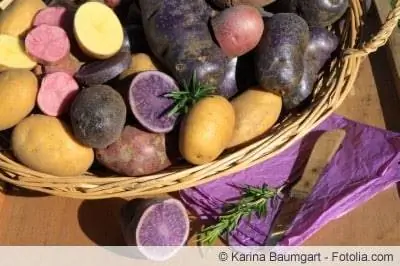
For potato lovers, blue or red potatoes can always be found on the market or as planting material, even in smaller quantities. So-called anthocyanins are responsible for the coloring and are said to have he alth-promoting aspects.
Red potato varieties
- Heiderot new breeding (2013): Country of origin Germany, long oval tuber, red peel and red flesh, ripening time medium early, waxy, buttery taste
- Highland Red Burgundy (Red Cardinal): Country of origin England (1902), floury cooking, oval tuber, medium late, strong taste
- Rosemarie (2004): Country of origin Germany, ripening time medium early, very long oval tuber, pink skin and pink flesh, creamy, slightly greasy consistency, waxy
Blue potato varieties
- Blue Anneliese (2004): Country of origin Germany, blue peel, purple flesh, round-oval tuber, ripening time medium early, waxy, strong taste
- Blue Bamberg croissants (very rare): country of origin Germany, ripening time late, slender croissant shape, blue shell and reddish-blue-white colored meat, waxy, good taste
- Blue Swede: country of origin unknown, oval tuber, black-purple skin and white-purple flesh, floury cooking
Conservation varieties
Old varieties that are of particular importance are called conservation varieties by the Federal Plant Variety Office. Some potato varieties are not economical enough for industrial, large-scale cultivation because they may not produce high yields, are sensitive to processing, or are susceptible to various diseases that monoculture entails. Since certain types of potatoes are very popular because of their good taste, they continue to be cultivated in small numbers by small farmers, organic farmers and hobby gardeners in their own gardens. These include:
- Ackersegen (1929): classic among floury potatoes, country of origin Germany, ripening time very late, round-oval tuber, ocher-colored skin and yellow flesh, strong spicy taste
- Bamberger Hörnchen (approx. 1870): horn-shaped tuber, late ripening, yellow-pink skin and yellow flesh, waxy, very good taste
New varieties

Several new varieties of potatoes are brought onto the market every year.
- SF Balu (2014): ripens early, predominantly waxy, long oval tuber, red peel and yellow flesh
- Torenia (2012): ripening time medium early, waxy, long oval tuber, yellow netted peel, yellow flesh
- Wega (2010): ripens early, predominantly waxy, oval tuber, yellow peel and deep yellow flesh color
- Wendy (2011): ripening time medium early, predominantly waxy, oval tuber with yellow skin and yellow flesh
Conclusion
In Germany there is an incredibly large selection of table potatoes. In order to make it easier for consumers to find their way around, the individual varieties are divided according to their cooking properties into waxy, predominantly waxy and floury. The ripening time, i.e. when a potato can be harvested, provides information about when it will be offered on the market. The time of harvest is also important for suitability for storage. The earlier a potato variety is harvested, the shorter it can be stored. Cellaring over the entire winter is only possible for late-harvested varieties.

